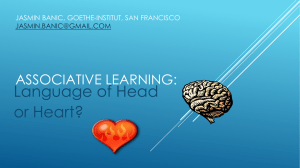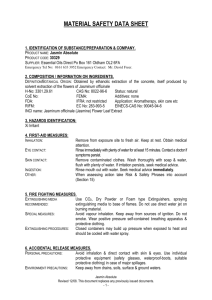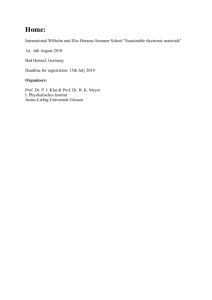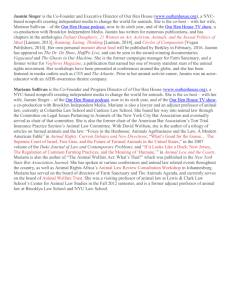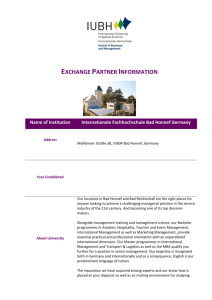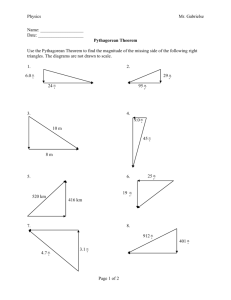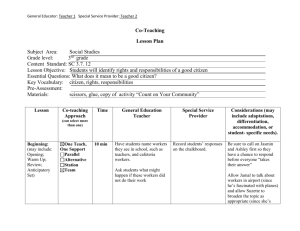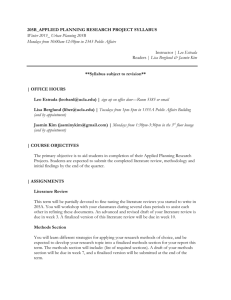Innovation in science education
advertisement
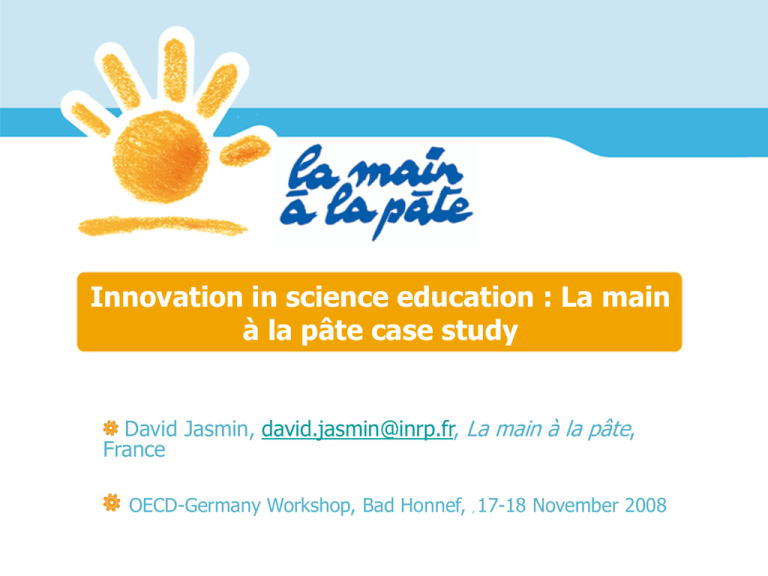
Innovation in science education : La main à la pâte case study David Jasmin, david.jasmin@inrp.fr, La main à la pâte, France OECD-Germany Workshop, Bad Honnef, , 17-18 November 2008 French Context Primary education • • • • 61 000 primary schools 350 000 classes Kindergarten: 99.5% of the 3 – 6 years old Elementary: 100 % of the 6 – 11 years old Primary school teachers • Polyvalent teachers (same teacher for all subjects) • Recruited at levels high school +0 (1960s) to high school +5 (1993) • 80 % literary Primary educational system • Top-down and pyramidal system • National curriculum but local diversity • Focus on reading/ writing/ counting In 1995 < 3% classes practicing science (Often biology, Frontal pedagogy..) 2 David Jasmin, Innovation in science education, OECD-Germany Workshop, Bad Honnef, , 17 November 2008 A brief history of La main à la pâte (2) 1995 – 1996 • Georges Charpak : Inquiry based science education (IBSE) small scale experimentation in 344 classes 1998 • Launch of the La main à la pâte Website 2000 • The experimentation has expanded to over 5 000 classes • The Ministry launch an official Plan for science teaching • Creation of La main à la pâte pilot centers • development of international partnerships 2002 • New official Curriculum inspired by La main à la pâte 2003-2008 • National resources for teachers and trainers ( guides/ DVD..) 2006 : launch of an experimental program (Integrated science and technology teaching for grade 6 – 7 and the European project : POLLEN 2007 • > 30 % teachers teach science with an active pedagogy • National K 5 pupils assessment in Science ( results in 2008) 3 David Jasmin, Innovation in science education, OECD-Germany Workshop, Bad Honnef, , 17 November 2008 From innovation to generalization… Main problem : quality and substainability Scale-up strategy Tools ( science note book, high quality resources …) Teacher training Use of Internet and other media Involving teachers in innovative projects Implication of the scientific community Creation of pilot centers with a systemic approach Partnership with institutions and no-conventional actors International cooperation 4 David Jasmin, Innovation in science education, OECD-Germany Workshop, Bad Honnef, , 17 November 2008 Teacher training : put teachers in children’s role 2 aspects : • • teaching practice scientific concepts Involve trainers & scientists To train teachers as children will be taught Embody theorical approach in a active practice of science for a sustainable and internal change of teaching Involve in resource productions (class sequences, books, Websites...) 5 David Jasmin, Innovation in science education, OECD-Germany Workshop, Bad Honnef, , 17 November 2008 Internet a powerful tool 200 000 visitors / month 10.000 registered people > 200 teachers free activities Scientists and trainers network.. www.lamap.fr 6 David Jasmin, Innovation in science education, OECD-Germany Workshop, Bad Honnef, , 17 November 2008 Innovative projects Beginning with shadows, angles & parallels Connect schools at different latitudes (> 10 countries) Determine Earth’s radius, dispersion of data Integrate Math, Astronomy, Measure, Geography, History, Writing Publication of a book + CDROM (2002) : for teachers & parents Other projects : Living with the Sun, European discoveries, Marco Polo… 7 David Jasmin, Innovation in science education, OECD-Germany Workshop, Bad Honnef, , 17 November 2008 Involvement of scientists in primary education (ASTEP) www.astep.fr Supporting in class Supporting collaborative projects Supporting through sponsorship ASTEP Supporting teacher training 8 Supporting resources production Supporting from a distance David Jasmin, Innovation in science education, OECD-Germany Workshop, Bad Honnef, , 17 November 2008 Creation of pilot centers : a systemic approach Website and forum Thematic projects Evaluation 9 training Teacher Material kits David Jasmin, Innovation in science education, OECD-Germany Workshop, Bad Honnef, , 17 November 2008 resource centres resources support by scientisits International networking Collaboration with > 30 countries and 3 regional areas through the network of Academy of sciences Example : La main à la pâte in Europe POLLEN European project (2006-2009 ), coordinated by La main à la pâte – 12 countries, 1500 teachers and 30000 pupils at the present time. Recent report from a group of European experts : Science education now : a renewed pedagogy for the future of Europe (May 2007) – Pollen and Sinus Transfer as reference projects. French Presidency of the European Union : international conference on science education – Paris, October 8-9, 2008. Next Project ? Fibonnacci : science City twinning… 10 David Jasmin, Innovation in science education, OECD-Germany Workshop, Bad Honnef, , 17 November 2008 Partenership and scale-up strategy Ministry of education Académie des sciences INRP Ecole normale supérieure Global strategy Scientific community Curricula Teachers training (IUFM/university) 11 • • • • Internet Site Resources Centers Pilot Centers/seed city Resources publication 350 000 classes (61 000 schools) David Jasmin, Innovation in science education, OECD-Germany Workshop, Bad Honnef, , 17 November 2008 Key elements for successful scaling-up Content : inquiry based pedagogy/ interdisciplinary/ new tools.. Organization : local model / teacher oriented / systemic approach/ local partners.. Politic : role of the Academy of science / partnership with ministry of education/ and prestigious scientific institutions / international cooperation Communication : focused on teachers/ media coverage through well-know scientists/ activities opened to parents.. 12 David Jasmin, Innovation in science education, OECD-Germany Workshop, Bad Honnef, , 17 November 2008 Conclusion In 10 years : science in 3% > 30% classes in primary school + a new experimentation in junior high schools Teacher training and coaching is the main issue for generalization Positive feedback from teachers, society and higher education For an effective impulsion and coordination, Academy of sciences, Ministry of Education and local authorities have to work hand in hand 13 David Jasmin, Innovation in science education, OECD-Germany Workshop, Bad Honnef, , 17 November 2008 Appendix General philosophy of La main à la pâte Science as an inquiry, as an investigation Something pupils do, not something that is done for them Teacher helps pupils to built their own knowledge Emphasis is put on • • • • • Interrogation Action Experimentation collective reconstruction not on learning statements to be memorized! Pupils get a deeper understanding when they try to present in an oral or written (science notebook) way their conclusion and to confront the with experimental results 15 David Jasmin, Innovation in science education, OECD-Germany Workshop, Bad Honnef, , 17 November 2008 The 10 principles of La main à la pâte Children observe & experiment on real, close objects/phenomena. Children argue and reason, share ideas, build knowledge. Teacher proposes activities organized in sequences, leaving ample space for children autonomy. Spend a minimum of 2 hours/week on same theme, for several weeks. Ensure continuity over the 5-6 years of elementary school. Have children keep their Experiment Notebook with their own words. Aim to an appropriation of scientific concepts/procedures along with a language (oral & written) acquisition. Associate family & neighborhood. Scientific partners to accompany the action. Involve the trainers : learning by doing. Create Internet resources & exchanges : www.inrp.fr/lamap 16 David Jasmin, Innovation in science education, OECD-Germany Workshop, Bad Honnef, , 17 November 2008 La main à la pâte partners INRP 17 David Jasmin, Innovation in science education, OECD-Germany Workshop, Bad Honnef, , 17 November 2008 Discussion list exchanges Message 1 : Hello, I am a teacher in grade 5 and we just started to study objects animated by the wind. Here are some of them : a windmill, the kind of mills you can find in funfairs, weathercocks, preferably " solid " ; kites that would be attached to big sticks in order to float, non-stuffed scarecrows… You can also use your imagination. Pupils also found for me plans in revision books, like Hatier, Hachette… Good luck for your " planting " Agnès Message 2 : Hello, I would advise you to go have a quick look on the website from the Paul Bert school in SENS. A complete work on " air, wind " has been carried out by these colleagues (NB : an article in the excellent magazine Moniteur92 (consulting address below) about the website) Cordially Michel Le journal des nouvelles technologies à l'école http://www.crdp.ac-versailles.fr/cddp92/monit92/default.htm 18 David Jasmin, Innovation in science education, OECD-Germany Workshop, Bad Honnef, , 17 November 2008 Questions to scientists Question Within the framework of manipulations about water, we made steam by heating water with 6-year olds. During the elaboration of the account, the children were willing to write: "the steam escapes and disappears in the air". The last remark bothers me in the way that after holding a glass over the steam, the children saw that there was condensation… What else can we say but " the steam disappears in the air " ? Jean Basdevant, researcher at the Ecole Polytechnique answers the question by e-mail within 48 hours... Hello, The children are always right. The steam disappears effectively; that is to say we don't see it any longer, it no longer "appears". The steam is a gaz composed with water that mixes to the air and that we don't see (like we don't see perfume we can smell in the air, though it has a color in the bottle). Water, thus mixed with air, can reappear as tiny drops, like in clouds or condensing over a glass, if the conditions help, for example if it is cold. Have a look at your kettle. The "steam" that comes out of it is visible. It condenses in droplets of water at its contact with the air around that is colder when it is dense, but then it gets diluted and… it disappears. It can also reappear by condensation on the windows or on the ceiling. Carry out the experiment to leave your glass near the steam for a long time. After some time, the steam will not condense on it any longer, because it will have heated up. I think there is confusion between " steam " that come out from steam-machines that you can see because it is condensed water, and real water steam that is water in a gaseous state like butane. 19 David Jasmin, Innovation in science education, OECD-Germany Workshop, Bad Honnef, , 17 November 2008 Questions to trainers Question What experiments can I carry out about salt marshes with 3 to 5 year olds ? Answer from Elisabeth Plé , trainer at the IUFM from Reims, center of Troyes, by e-mail within 48 hours... You can make yourself a small salt marsh by putting sea water (since you live in La Rochelle) to evaporate. You will then look for ideal conditions for the evaporation to work. Of course, in kindergarten, it is not possible to consider a separation of factors, but you can try to find a solution to " spread out " water under the sun, like in a salt marsh. For example, you can put the water under the sun in plates or iron biscuit box tops. The operation takes a long time. You can also try to find with the children other ways to heat water. For them, the sun takes the water away , " drinks it " ; the representation of the sun as a source of heat is not immediate. It is an obstacle to know about when you want to carry out this type of work. When you get over it, you can heat the sea water in a sauce pan and get the white powder that appears, miraculously for the children. It is also interesting to " make " sea water and to get back the salt you put in it. You work on the (visible) disappearance of the salt by adding water, and then the reappearance by evaporation (in the saucepan). The progression. If the children from your class in La Rochelle are not very familiar with salt marshes, it might as well be interesting to carry out researches in class, to become a salt producer, and then to go visit the salt marsh. The children will then ask questions to a specialist with " producer questions ". They have a better view of the small-scale and industrial making process. 20 David Jasmin, Innovation in science education, OECD-Germany Workshop, Bad Honnef, , 17 November 2008 Scientific patronage Example : Integrated science and technology teaching (grade 6 - 7) • • • 30 junior high schools officially engaged in 5 French counties regions For each region : a science academician patronage In each secondary school, a single teacher (biology- geology, physics-chemistry or technology) for each group of pupils 3.5 to 4.5 hours of « Science and technology » per week TEACHING RESSOURCES: http://science-technocollege.net/ Progressive guidelines and teaching materials proposed by the Académie des sciences (available online): • - “What is the world made of ? ” Mater and materials (grade 6) • - “How does the world work? ” Energy and energies (grade 5) Resource book written by professional scientists David Jasmin, Innovation in science education, OECD-Germany Workshop, Bad Honnef, , 17 November 2008 Inquiry based science in the World Quebec Haiti Mexico Belgium Serbia Afghanistan Romania Morocco Slovaquia Sri Lanka Algeria Associated countries Hands-on La main à la pâte Direct collaborations 22 Colombia Brazil Chile Senegal Lebanon Madagascar Gabon Egypt Mauritius David Jasmin, Innovation in science education, OECD-Germany Workshop, Bad Honnef, , 17 November 2008 China Vietnam S. Korea Malaysia
